Whether or not you’re singing a nursery rhyme or constructing studying abilities, poetry is a good way to interact college students. It’s by no means too early to introduce them to this splendidly expressive and versatile type of literature. We’ve put collectively this assortment of candy kindergarten poems and nursery rhymes for teenagers to share in your classroom.
FREE PRINTABLE
Poetry Worksheet Bundle
Click on the button under to obtain our bundle of free poetry worksheets for grades Okay-2.
1. All of Me by Greg Smedley-Warren
“My fingers are for clapping …”
Themes: Self-awareness, motion
Literary gadgets: Rhyme, repetition
This playful poem encourages youthful children to acknowledge and admire completely different elements of their physique by way of motion and motion. Not solely is it nice for kinesthetic studying and vocabulary constructing, however it additionally reinforces ideas about self-identity and bodily consciousness.
2. Hot Sun by Kenn Nesbitt
“‘Scorching solar!
What enjoyable!
I’ll swim!’
mentioned Tim.”
Themes: Summer time enjoyable, warmth, penalties
Literary gadgets: Rhyme, repetition
It’s easy, however this partaking poem captures the joy of a sizzling, sunny day. It may be used to introduce weather-related discussions, sequencing occasions, and cause-and-effect relationships in storytelling.
“The cat and the fiddle …”
Themes: Nonsense, creativeness, playfulness
Literary gadgets: Rhyme, personification, alliteration
Many will acknowledge this traditional nursery rhyme, which is great for serving to youngsters acknowledge rhyming patterns whereas fostering creativity and creativeness. It additionally gives a chance to debate how animals and objects will be personified in poetry.
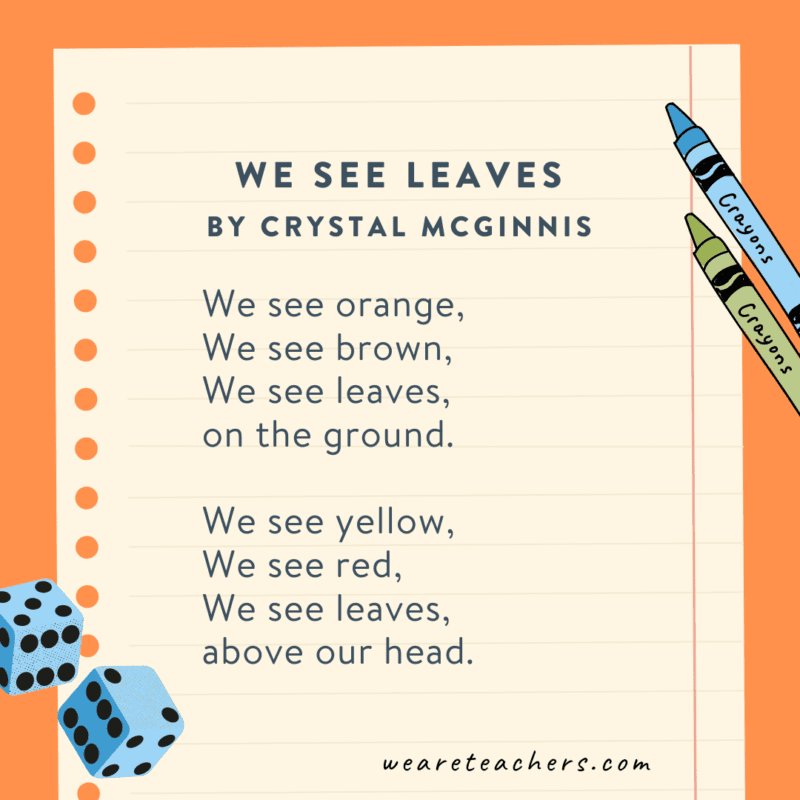
“We see orange, we see brown …”
Themes: Seasons, commentary, nature
Literary gadgets: Repetition, imagery
This straightforward, descriptive poem encourages younger learners to watch and describe modifications in nature, significantly in autumn. It’s ideally suited for classes on colours, seasons, and descriptive language.
“Climbed up the waterspout.”
Themes: Perseverance, nature
Literary gadgets: Rhyme, repetition, personification
This well-known, sing-along nursery rhyme teaches resilience and willpower. When carried out together with the traditional actions, it’s additionally nice for movement-based studying and sequencing actions.
6. No Pencil by Kenn Nesbitt
“No marker.
No paint brush.
No pen.”
Themes: Creativity, creativeness
Literary gadgets: Repetition, distinction
This poem emphasizes that you simply don’t want instruments to be inventive—we will use our fingers, voices, and concepts to specific ourselves. It’s additionally helpful for discussions on completely different types of inventive expression and pondering exterior the field.
“The Owl and the Pussy-cat went to sea …”
Themes: Journey, love, fantasy
Literary gadgets: Rhyme, narrative construction, imagery
A whimsical poem that tells a whimsical story of an owl and a cat on a journey, it’s ideally suited for introducing storytelling components, rhyme schemes, and discussing how poems can create total worlds by way of imagery.
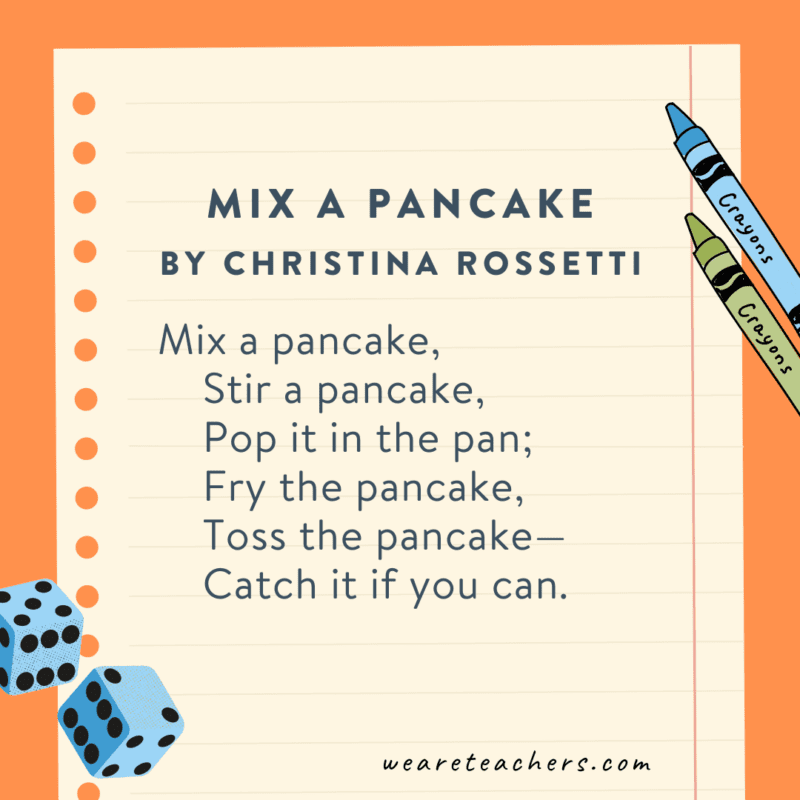
“Pop it within the pan.”
Themes: Cooking, each day life, rhythm
Literary gadgets: Rhyme, repetition
This rhythmic, action-oriented poem can be utilized to introduce sequencing and procedural writing, in addition to connect with real-world actions like cooking and following directions.
“Some are completely different, some the identical.”
Themes: Identification, variety, inclusivity
Literary gadgets: Repetition, rhythm
This poem emphasizes that everybody has a reputation, some distinctive and a few frequent, making it excellent for classes on identification, vanity, and celebrating variety within the classroom.
10. Flag by Shel Silverstein
“One star is for Alaska …
One star is for Nebraska …”
Themes: Patriotism, geography, perspective
Literary gadgets: Rhyme, symbolism
This poem makes use of humor and intelligent wordplay to introduce youngsters to the idea of states and nationwide symbols. Use for early social research classes and discussing the which means of flags in several cultures.
“However the place are all of the bees?”
Themes: Nature, curiosity, counting
Literary gadgets: Rhyme, repetition, suspense
This traditional fingerplay poem engages children with a enjoyable buildup to the bees “buzzing out.” Use it to show counting, sequencing, and early science classes about bees and their position in nature.
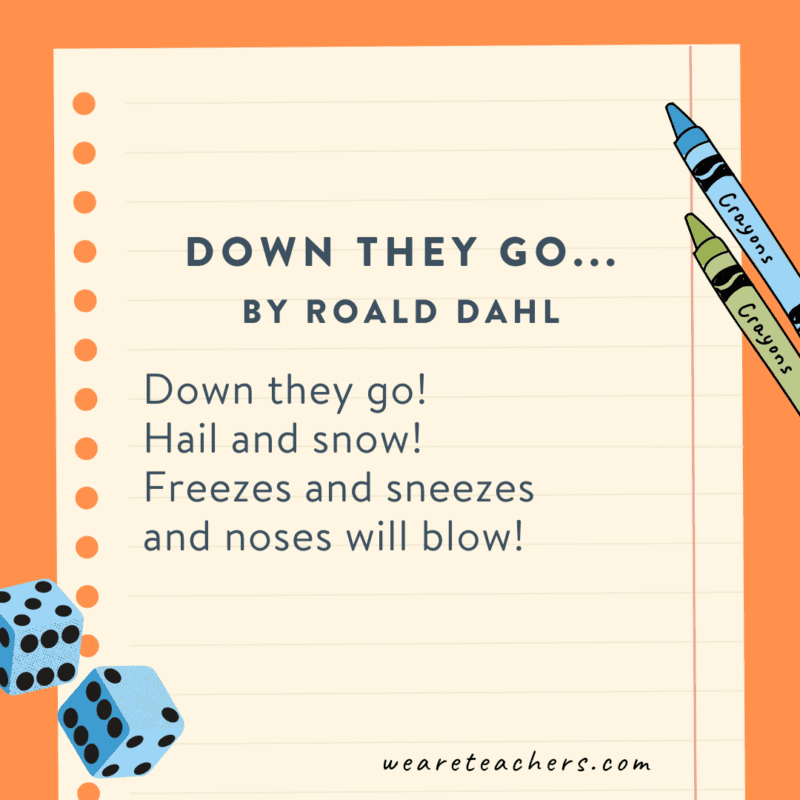
“Hail and snow!”
Themes: Climate, change, motion
Literary gadgets: Rhyme, alliteration, imagery
This full of life poem captures the power of hail and snow falling, making it nice for discussing climate patterns, descriptive writing, and onomatopoeia.
“Have you ever any milk?”
Themes: Animals, farming, question-and-answer format
Literary gadgets: Rhyme, repetition, dialogue
This straightforward, rhythmic poem helps children discover cattle and their sounds. It may be helpful for interactive studying, reinforcing animal vocabulary, and training question-and-answer constructions.
14. Apples by Writer Unknown
“Apples within the attic …”
Themes: Nature, seasons, meals
Literary gadgets: Rhyme, repetition, imagery
A descriptive poem about apples and the place they is likely to be discovered, it may be helpful for classes on fall, fruit, and sensory language in poetry.
15. Leaves by Sue Schueller
“Leaves on the pumpkin …”
Themes: Seasons, nature, commentary
Literary gadgets: Imagery, alliteration
This poem captures the fantastic thing about falling leaves and their connection to autumn, making it a strong selection for classes on seasonal modifications, descriptive writing, and visible imagery.
16. Water by Mrs. Parisi
“Water for the flowers …”
Themes: Nature, necessity, sustainability
Literary gadgets: Repetition, symbolism
This straightforward poem highlights the significance of water for crops, animals, and other people, making it a beautiful instrument for discussing the water cycle, conservation, and real-world science connections.
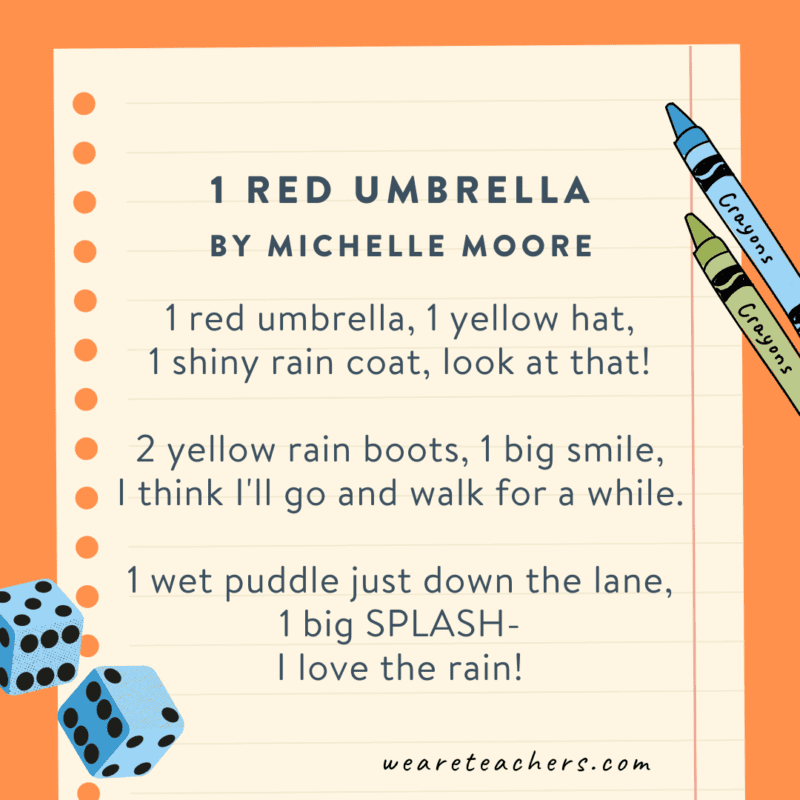
“1 purple umbrella, 1 yellow hat …”
Themes: Colours, counting, climate
Literary gadgets: Rhyme, repetition, sequencing
This partaking counting poem introduces numbers and colours in a enjoyable, visible approach. It’s helpful for early math abilities, climate discussions, and training descriptive vocabulary.
“I noticed a noticed. I felt some felt.”
Themes: Humor, wordplay, sensory language
Literary gadgets: Pun, alliteration, homophones
This playful poem mixes up the senses in a enjoyable and foolish approach, making it nice for instructing homophones, wordplay, and the 5 senses.
19. Ice Cream by Cara Carroll
“Ice cream in a bowl …”
Themes: Meals, enjoyment, summer time
Literary gadgets: Rhyme, repetition, sensory imagery
This enjoyable, relatable poem makes use of sensory particulars to explain consuming ice cream. This will help classes on adjectives, descriptive writing, and private experiences.
“Draw a loopy image, write a nutty poem …”
Themes: Creativeness, creativity, playfulness
Literary gadgets: Rhyme, metaphor, humor
This poem affords a lesson in creativity and creativeness. It teaches children that it’s OK to be foolish typically and encourages them to assume exterior the field.
“I by no means noticed a Purple Cow …”
Themes: Humor, absurdity, perspective
Literary gadgets: Rhyme, irony, exaggeration
This brief, humorous poem playfully imagines an not possible situation — a purple cow. It’s a enjoyable approach to introduce youngsters to nonsense poetry, discussing exaggeration in literature, and humor.
“You may have a magic carpet
That may whiz you thru the air …”
Themes: Feelings, actions, engagement
Literary gadgets: Repetition, call-and-response construction
This can be a traditional motion poem/tune that helps youngsters specific feelings by way of motion. It’s helpful for social-emotional studying, gross motor abilities improvement, and reinforcing constructive expressions of emotions.
“Clap your fingers …”
Themes: Feelings, self-expression, motion
Literary gadgets: Repetition, call-and-response, rhythm
This much-loved tune encourages youngsters to specific feelings by way of motion. Use the playful construction and cumulative actions to show social-emotional studying, following instructions, and fascinating in group participation.
“How I ponder what you might be …”
Themes: Marvel, curiosity, nature
Literary gadgets: Rhyme, personification, simile
This timeless poem’s prolonged verses emphasize the star’s position in lighting the best way for vacationers. It’s excellent for instructing rhyme schemes, personification (the star “twinkling” and “peeping”), and similes (evaluating the star to a diamond).
25. My Shadow by Robert Louis Stevenson
“I’ve a little bit shadow that goes out and in with me …”
Themes: Statement, curiosity, childhood surprise
Literary gadgets: Rhyme, personification, imagery
This playful poem personifies the shadow, treating it as a companion that grows, shrinks, and even “sleeps in mattress.” It’s glorious for classes on descriptive language, personification, and scientific discussions about mild and shadows.
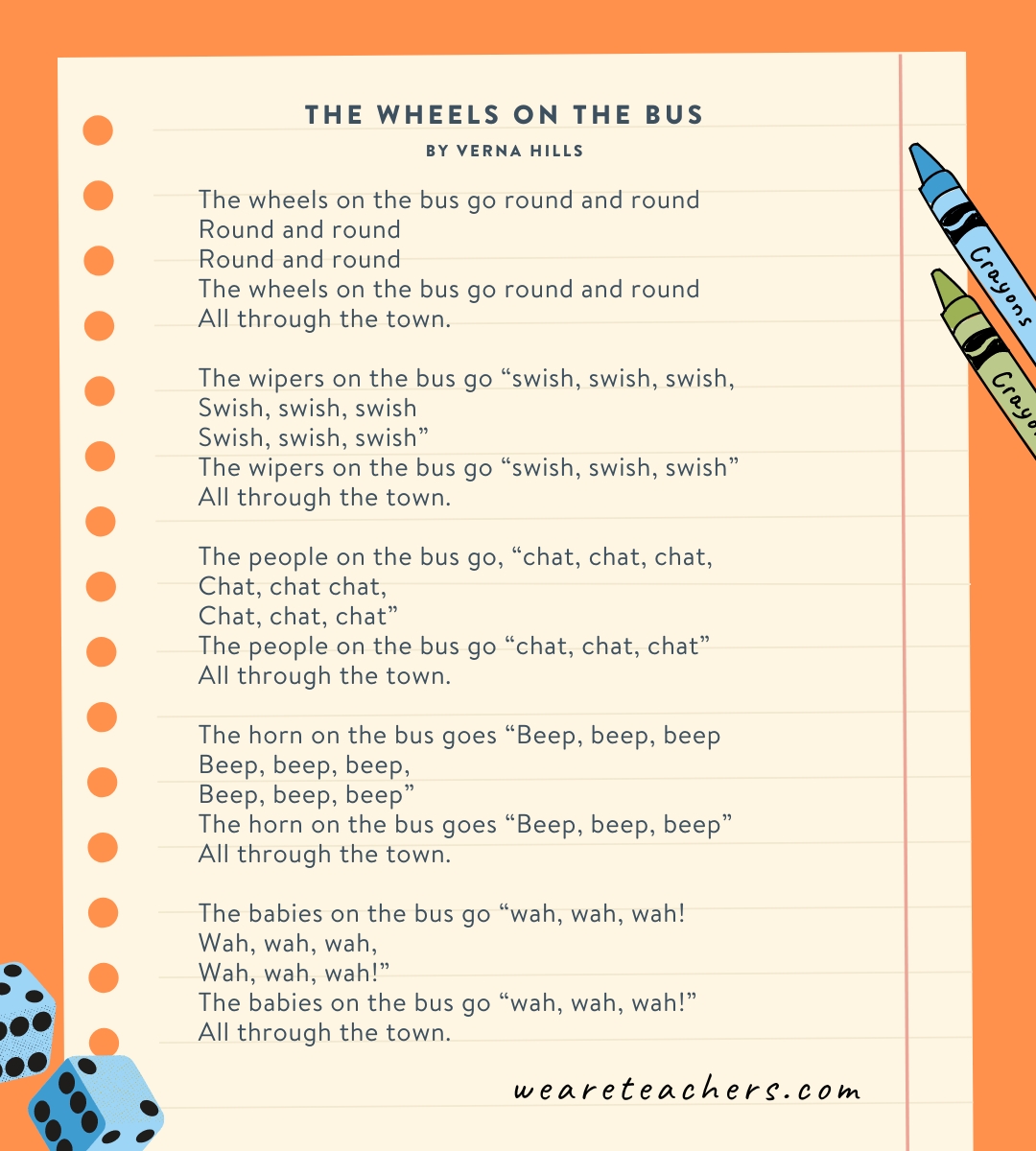
“Go spherical and spherical …”
Themes: Transportation, group, motion
Literary gadgets: Repetition, onomatopoeia, rhythm
This traditional youngsters’s tune’s repetitive phrases and actions reinforce early language abilities and coordination. The usage of onomatopoeia (e.g., “beep, beep, beep” and “swish, swish, swish”) helps children join sounds with real-world actions.
27. The Moon by Robert Louis Stevenson
“The moon has a face just like the clock within the corridor …”
Themes: Nighttime, nature, distinction between day and night time
Literary gadgets: Rhyme, personification, simile, imagery
Evaluating it to a clock, this light poem describes how the moon illuminates the world whereas daytime creatures relaxation. The poem is great for instructing personification, similes (e.g., “The moon has a face just like the clock within the corridor”), and contrasts between day and night time.
“Have you ever any wool?”
Themes: Sharing, generosity, historic commerce
Literary gadgets: Rhyme, repetition, dialogue
This traditional nursery rhyme teaches youngsters about sharing and generosity. The repetitive construction helps with early literacy abilities, and the straightforward question-and-answer format encourages participation.
“As soon as upon a time, there have been 4 little Rabbits …”
Themes: Curiosity, penalties, journey
Literary gadgets: Narrative construction, characterization, personification, imagery
This beloved story teaches necessary classes about penalties, decision-making, and duty. With its vivid descriptions and fascinating plot, it’s excellent for classes on storytelling components, personification, character improvement, and cause-and-effect relationships.
“And on his farm, he had a cow …”
Themes: Animals, sounds, farming, repetition
Literary gadgets: Repetition, onomatopoeia, call-and-response
The interactive construction of this traditional youngsters’s tune encourages participation, making it ideally suited for growing early language abilities, phonemic consciousness, and reminiscence retention. It can be used to introduce discussions about farms, animals, and the place meals comes from.
“The happier we’ll be …”
Themes: Friendship, group, inclusivity
Literary gadgets: Repetition, rhythm, call-and-response
This uplifting folks tune reinforces the enjoyment of friendship and togetherness, making it a wonderful instrument for instructing social-emotional studying, cooperation, and kindness. The repetitive lyrics and easy-to-sing melody assist younger learners develop language abilities whereas encouraging participation.
“Humpty Dumpty sat on a wall …”
Themes: Cautionary story, penalties
Literary gadgets: Rhyme, metaphor
This well-known cautionary story’s rhythmic construction and repetition help early literacy abilities. Lecturers can use it for inventive actions corresponding to retelling the story with various endings and exploring completely different problem-solving methods.
33. Rain by Robert Louis Stevenson
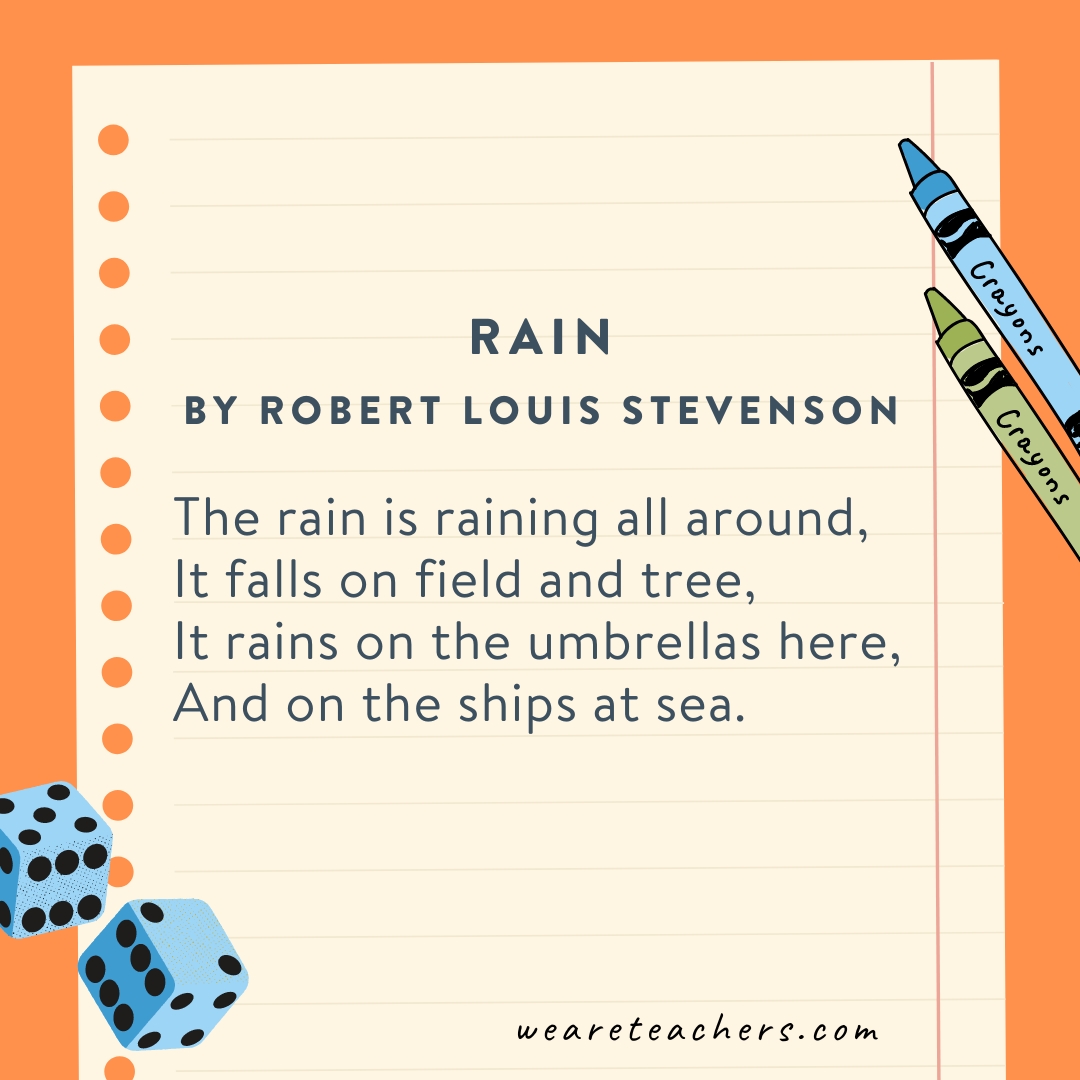
“The rain is raining throughout …”
Themes: Climate, nature, commentary
Literary gadgets: Rhyme, imagery
A easy however lovely reflection on rain and the way it nourishes the world, making it helpful for climate classes, sensory language, and poetry appreciation.
“We’re occurring a bear hunt …”
Themes: Journey, bravery, problem-solving, perseverance
Literary gadgets: Repetition, onomatopoeia, call-and-response, rhythm
This interactive, rhythmic story’s repeated phrases and sound results (“swishy swashy,” “squelch squerch”) make it partaking for teenagers whereas reinforcing sequencing and storytelling abilities. The poem additionally teaches resilience and teamwork, because the characters face challenges however proceed their journey.
35. A Wise Old Owl by Edward Hersey Richards
“Lived in an oak …”
Themes: Knowledge, listening, persistence, self-control
Literary gadgets: Rhyme, personification, symbolism
This brief however insightful poem teaches the worth of listening extra and talking much less. The sensible owl symbolizes thoughtfulness and cautious commentary, making it an ideal dialogue starter for classes on communication abilities, important pondering, and emotional intelligence.
“Its fleece was white as snow …”
Themes: Friendship, kindness, animals, persistence, loyalty
Literary gadgets: Rhyme, repetition, personification, simile
This beloved nursery rhyme tells the story of a faithful lamb, highlighting themes of affection, loyalty, and companionship. It’s actually excellent for discussions on empathy and kindness. The simile “Its fleece was white as snow” introduces figurative language, whereas the rhyming sample helps with early literacy abilities.
“In the event you go down within the woods at this time …”
Themes: Creativeness, playfulness, secrecy, journey
Literary gadgets: Rhyme, repetition, imagery, personification
This whimsical poem-song makes use of vivid imagery, personification, and a playful tone. It makes it ideally suited for imaginative writing workouts, encouraging inventive pondering and storytelling.
38. The Swing by Robert Louis Stevenson
“How do you wish to go up in a swing,
Up within the air so blue?”
Themes: Pleasure, freedom, motion
Literary gadgets: Rhyme, imagery
This poem’s use of vivid imagery lets children expertise the enjoyment of seeing the world from above, making it a strong selection for classes on sensory particulars and descriptive writing. The poem’s rhythmic circulation mirrors the movement of a swing, reinforcing its theme of freedom and play.
“Within the nice inexperienced room …”
Themes: Consolation, bedtime, routines, commentary, mindfulness
Literary gadgets: Repetition, rhyme, imagery, personification
This beloved bedtime poem makes use of a soothing rhythm and repetitive construction assist create a chilled environment, making it glorious for discussions on routines, mindfulness, and the ability of commentary. The poem’s personification of on a regular basis objects (“Goodnight moon,” “Goodnight air”) encourages youngsters to see the world with a way of surprise.
40. Cloud by Nancy VandenBerge
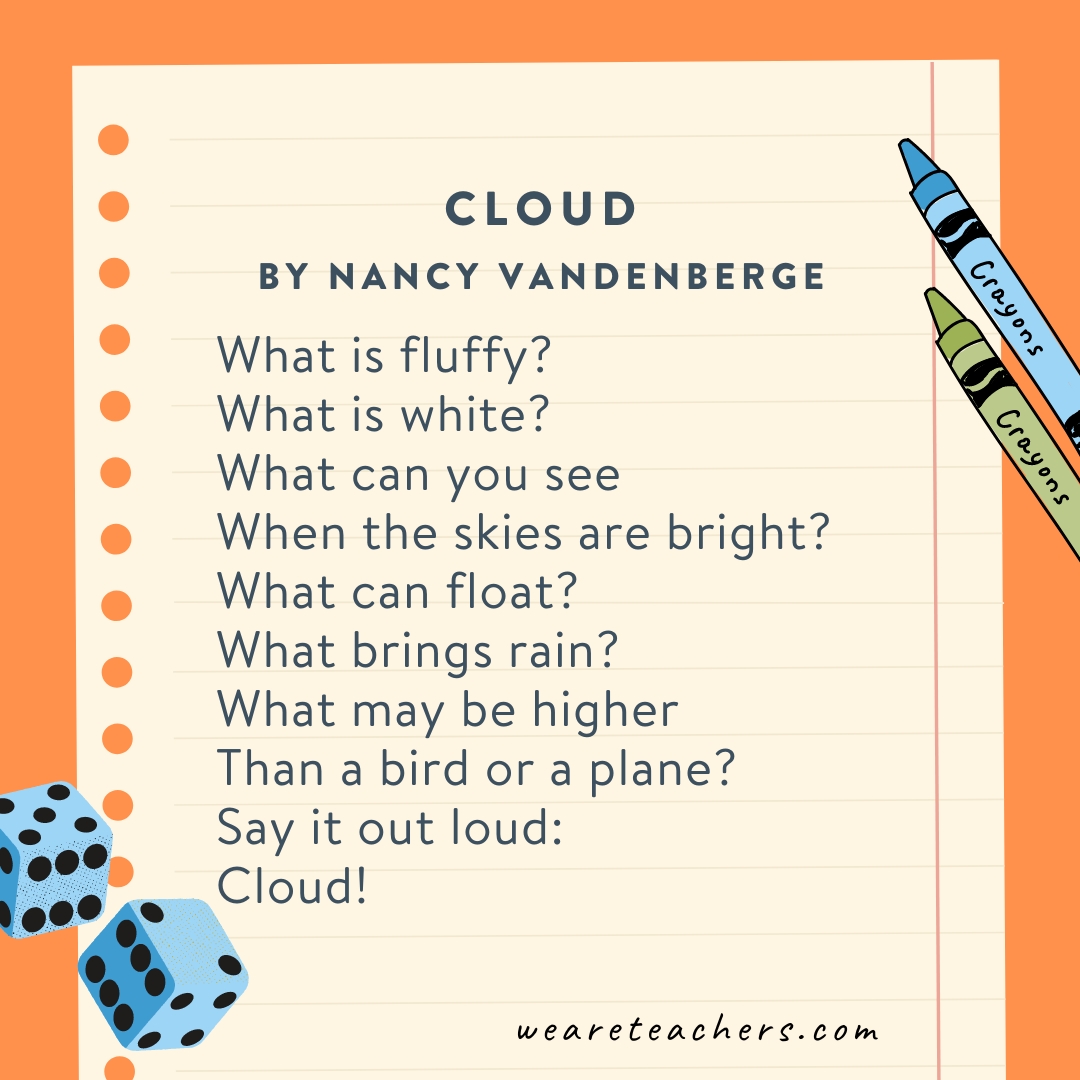
“What’s fluffy?”
Themes: Nature, commentary, curiosity
Literary gadgets: Rhyme, imagery
With its descriptive language and playful tone, this poem fosters curiosity concerning the pure world and can be utilized to introduce discussions on climate, seasons, and inventive interpretation. Lecturers can use this poem as a springboard for inventive writing, encouraging college students to explain what they see within the sky and picture tales behind the clouds.
Get my free poetry worksheet bundle!
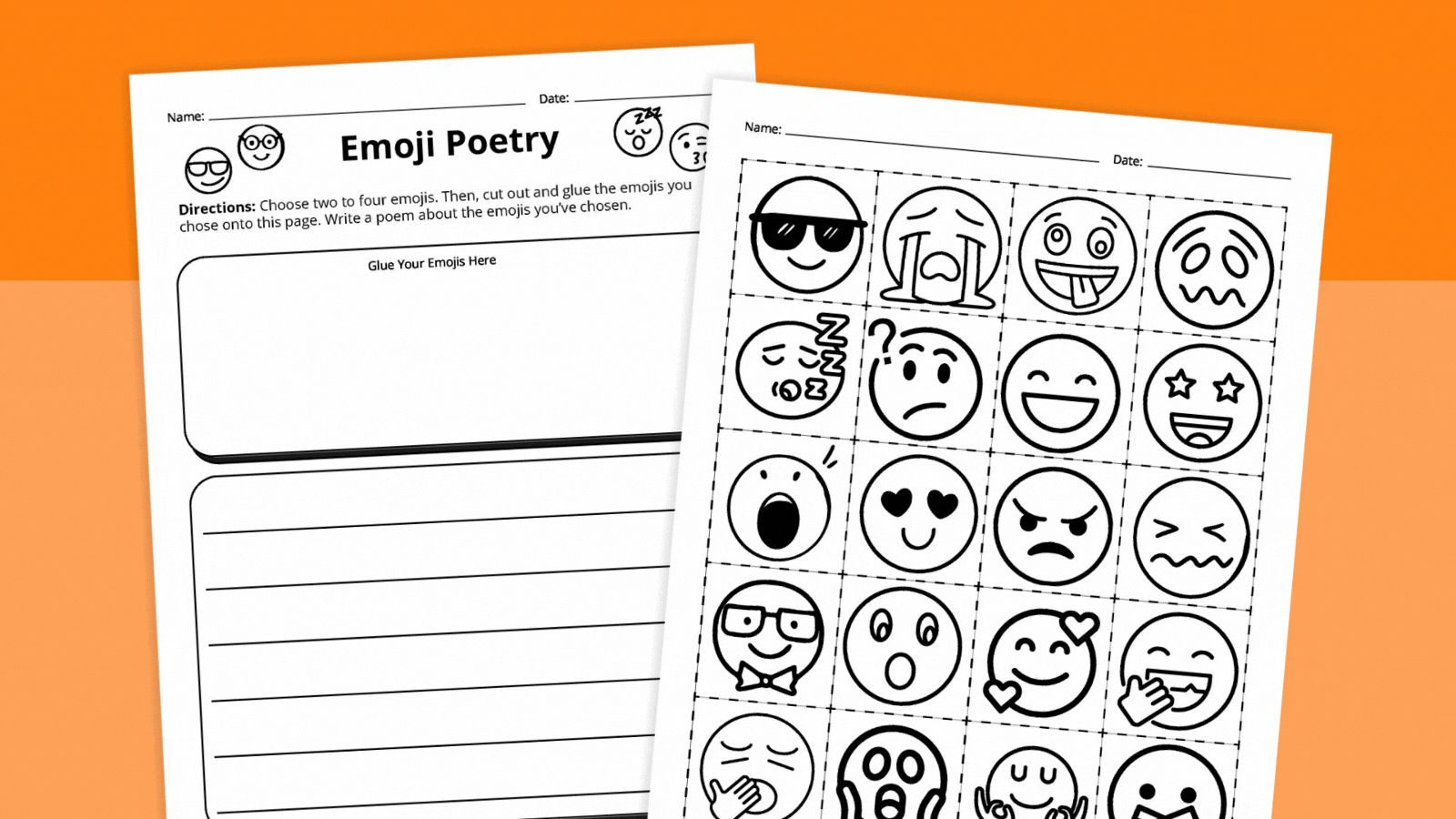
Click on the button under to obtain our printable poetry worksheets and actions to share together with your class. It’s excellent for grades Okay-2.
In the event you like these kindergarten poems, make sure you subscribe to our newsletters to search out out once they’re posted.
Plus, take a look at our kindergarten classroom hub for kindergarten classes, ebook lists, and extra!
Trending Merchandise










